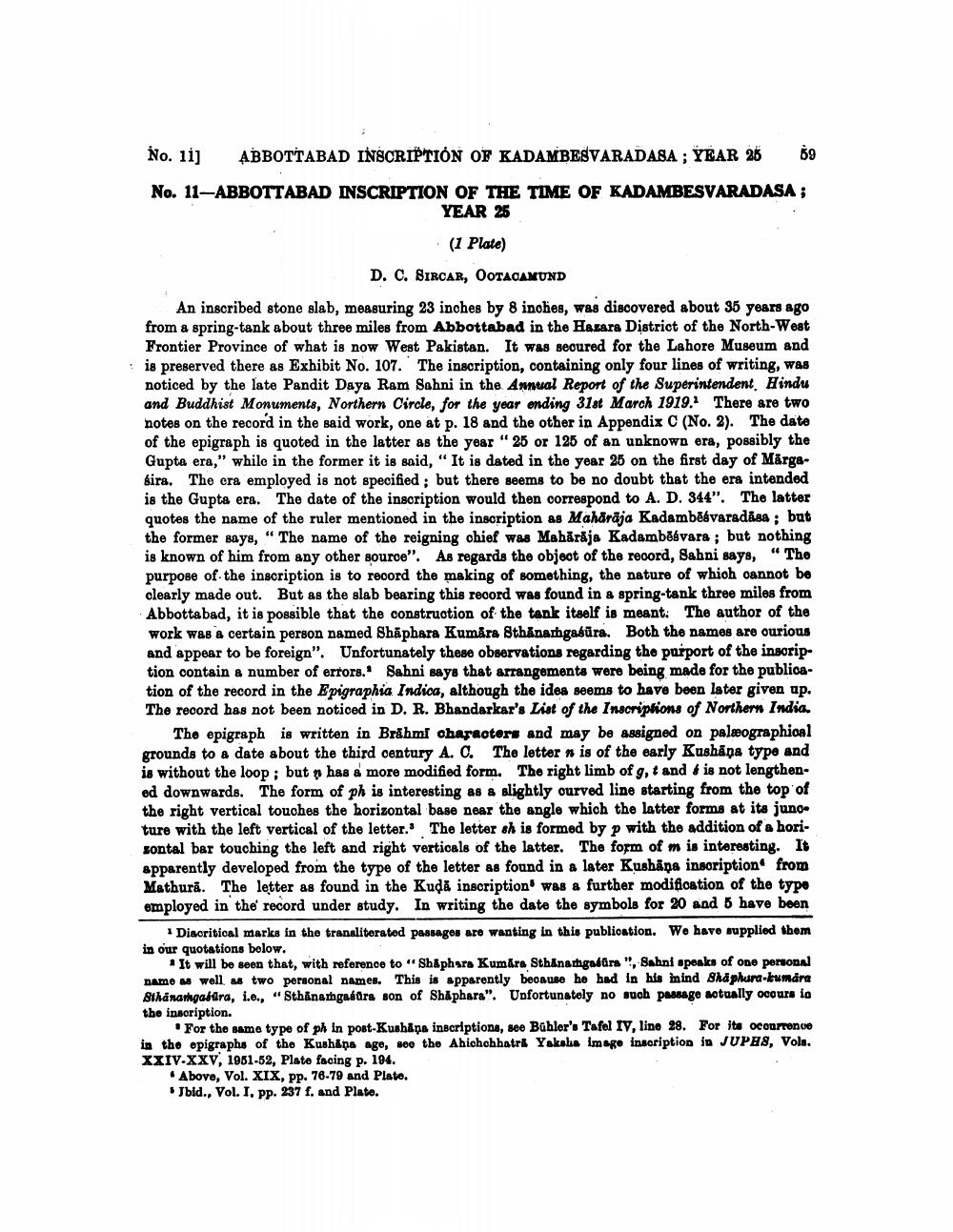________________
No. 111
ABBOTTABAD INSCRIPTION OF KADAMBESVARADASA; YEAR 25
No. 11-ABBOTTABAD INSCRIPTION OF THE TIME OF KADAMBESVARADASA;
YEAR 25
(1 Plate)
D. C. SIRCAR, OOTACAMUND
An inscribed stone slab, measuring 23 inches by 8 inches, was discovered about 35 years ago from a spring-tank about three miles from Abbottabad in the Hazara District of the North-West Frontier Province of what is now West Pakistan. It was secured for the Lahore Museum and is preserved there as Exhibit No. 107. The inscription, containing only four lines of writing, was noticed by the late Pandit Daya Ram Sahni in the Annual Report of the Superintendent, Hindu and Buddhist Monuments, Northern Circle, for the year ending 31st March 1919. There are two notes on the record in the said work, one at p. 18 and the other in Appendix C (No. 2). The date of the epigraph is quoted in the latter as the year "25 or 125 of an unknown era, possibly the Gupta era," while in the former it is said, "It is dated in the year 25 on the first day of Margasira. The era employed is not specified; but there seems to be no doubt that the era intended is the Gupta era. The date of the inscription would then correspond to A. D. 344". The latter quotes the name of the ruler mentioned in the inscription as Maharaja Kadambesvaradasa; but the former says, "The name of the reigning chief was Mahārāja Kadambéévara; but nothing is known of him from any other source". As regards the object of the record, Sahni says, "The purpose of the inscription is to record the making of something, the nature of which cannot be clearly made out. But as the slab bearing this record was found in a spring-tank three miles from Abbottabad, it is possible that the construction of the tank itself is meant. The author of the work was a certain person named Shaphara Kumara Sthanarhgasura. Both the names are curious and appear to be foreign". Unfortunately these observations regarding the purport of the inscription contain a number of errors. Sahni says that arrangements were being made for the publication of the record in the Epigraphia Indica, although the idea seems to have been later given up. The record has not been noticed in D. R. Bhandarkar's List of the Inscriptions of Northern India.
69
The epigraph is written in Brähml characters and may be assigned on palæographical grounds to a date about the third century A. C. The letter n is of the early Kushana type and is without the loop; but has a more modified form. The right limb of g, t and is not lengthened downwards. The form of ph is interesting as a slightly curved line starting from the top of the right vertical touches the horizontal base near the angle which the latter forms at its junc ture with the left vertical of the letter. The letter sh is formed by p with the addition of a horizontal bar touching the left and right verticals of the latter. The form of m is interesting. It apparently developed from the type of the letter as found in a later Kushana inscription from Mathura. The letter as found in the Kuda inscription' was a further modification of the type employed in the record under study. In writing the date the symbols for 20 and 5 have been
1 Diacritical marks in the transliterated passages are wanting in this publication. We have supplied them in our quotations below.
It will be seen that, with reference to "Shaphara Kumara Sthanamgadura", Sahni speaks of one personal name as well as two personal names. This is apparently because he had in his mind Shaphura-kumāra Sthanamgabara, i.e., "Sthanamgastra son of Shaphara". Unfortunately no such passage actually occurs in the inscription.
For the same type of ph in post-Kushapa inscriptions, see Bühler's Tafel IV, line 28. For its occurrence in the epigraphs of the Kushina age, see the Ahichchhatra Yaksha image inscription in JUPHS, Vols. XXIV-XXV, 1951-52, Plate facing p. 194.
Above, Vol. XIX, pp. 76-79 and Plate. Jbid., Vol. I. pp. 237 f. and Plate.




